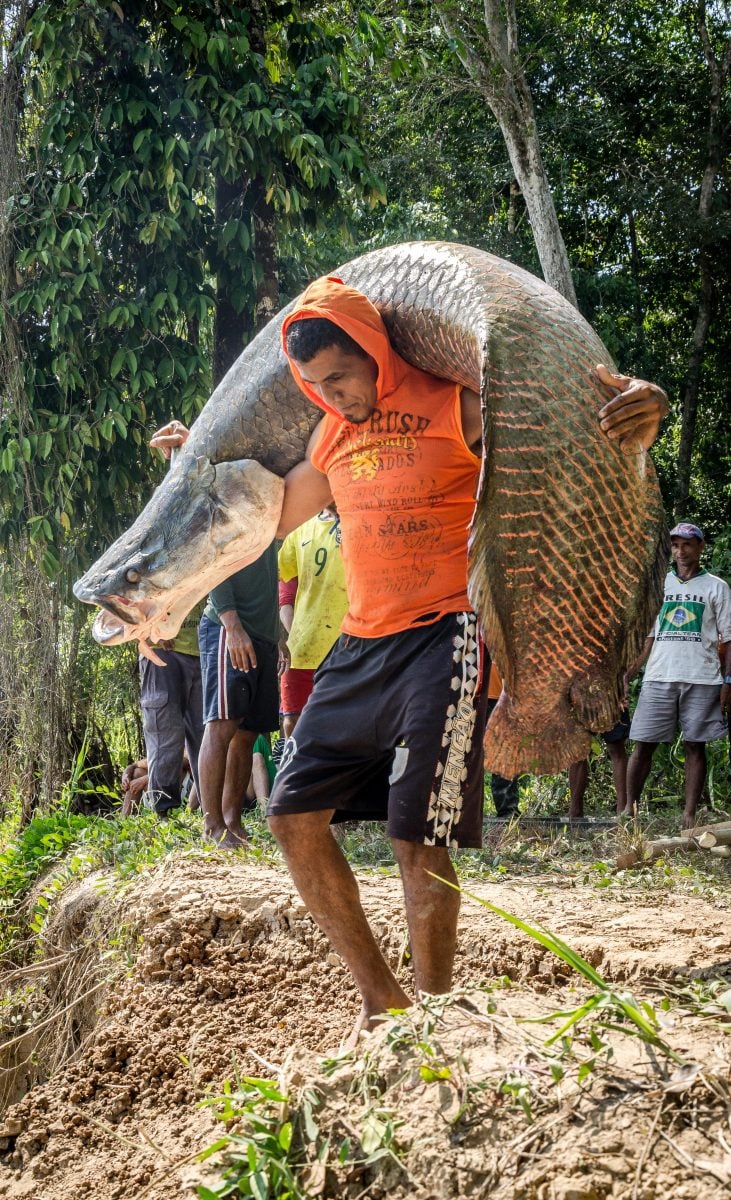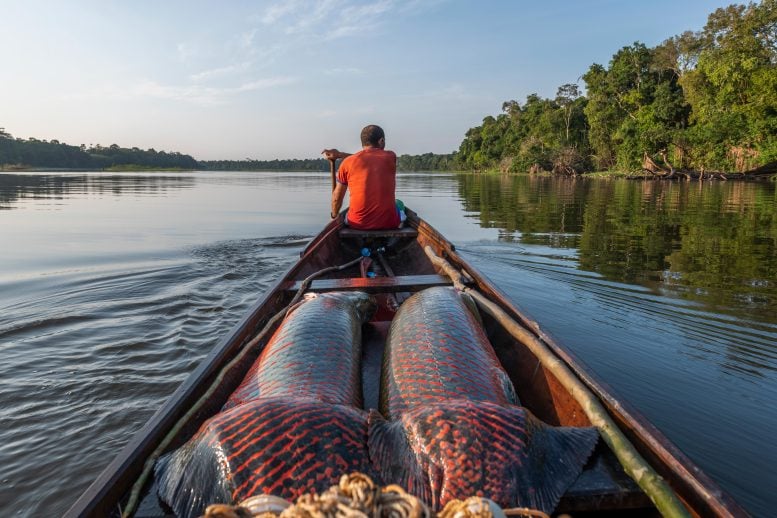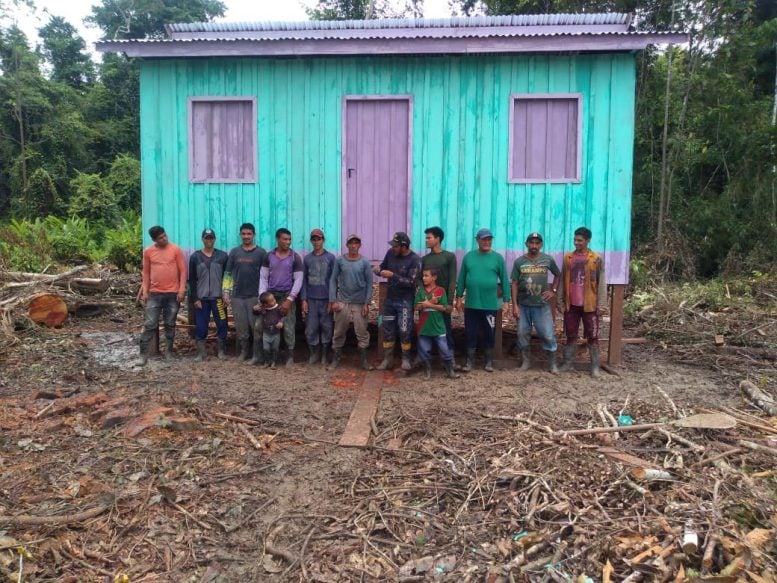Amazon Communities Deliver “Unprecedented” Conservation Wins
Local community member engaged in Community-Based Management (CBM) carrying a large wild-caught Arapaima fish. Credit: Hugo CM Costa / Instituto JuruaLocal Amazon communities protect ecosystems while sustaining fisheries. Support is needed to keep efforts viable. New research highlights “unprecedented” conservation outcomes achieved through community-led management of protected areas in the Amazon, at a time when many of these regions face increasing threats from weak regulatory enforcement, external encroachment, and competition for natural resources. The study outlines a promising approach for expanding effective area-based protection by building on existing community practices for managing local resources. Conventional protected areas in the tropics often struggle due to limited staffing, scarce funding, and inadequate equipment. These shortcomings raise concerns about how such areas can be maintained under financial constraints and in the face of unsupportive political environments. Efforts to expand formally designated protected areas have also slowed, despite renewed global commitments to safeguard 30% of the planet’s land and seas by 2030, a target reaffirmed in the Kunming-Montreal Global Biodiversity Framework of the Convention on Biological Diversity (CBD) three years ago. Community-based management as a conservation solution The findings, published in Nature Sustainability, come from a collaboration between researchers in Brazil and the UK. They suggest that one way forward is to strengthen Other Effective Area-Based Conservation Measures (OECMs), which refer to regions managed in ways that deliver sustained biodiversity protection. The research team, representing the Instituto Juruá (Brazil), University of East Anglia (UK), Universidade Federal de Alagoas (Brazil), and Instituto Nacional de Pesquisas da Amazonia (Brazil), examined the conservation benefits of community-based fisheries management along a 1,200-kilometer stretch of the Juruá River, a major Amazon tributary in the state of Amazonas. A local fisherman paddling a large dugout canoe after a successful fishing trip into one of the community-managed lakes protected by his community. Credit: Andre Dib / Instituto JuruáTheir results show that when accounting for all areas under direct or indirect protection, each community safeguards floodplain and upland forest nearly 86 times larger than the dry-season surface area of oxbow lakes that support local arapaima fish populations. Across the state of Amazonas, this management approach has protected approximately 15 million hectares of floodplain forest. Local enforcement, biodiversity gains, and community benefits Professor Carlos Peres, from UEA’s School of Environmental Sciences and a senior author on the paper, said: “This study clearly demonstrates the effectiveness of empowering local management action by stakeholders who have the greatest interest and a 24-7, year-round presence where conservation battles are being won or lost. “The conservation dividends from community-based protection are unprecedented and deployed at a tiny fraction of the financial costs of traditional protection mechanisms. In practice, this makes local land managers true ‘unsung heroes’ in the cacophony of theoretical conservation discourse.” Through locally coordinated enforcement and active surveillance, local communities in the western Brazilian Amazon mount concerted efforts to protect oxbow lakes, where commercially valuable fisheries are managed, against exploitation by outsiders. These communities then benefit from an annual windfall in sales of sustainably harvested fish, accrued from the local harvesting of protected populations of key resources, which also boosts populations of several other non-target co-occurring species that have been historically overexploited, such as giant otters, manatees, and giant Amazon River turtles. Long-term challenges and policy implications The study authors call for more recognition and financial support for these crucial conservation efforts, which play a significant role in protecting the vast Amazon biome. Without adequate support, they warn that the long-term sustainability of this model, dependent on unpaid labor and costs borne by communities, may be uncertain. Dr Ana Carla Rodrigues from Universidade Federal de Alagoas led the study. She said: “We have shown how Amazonian community-based management can protect vast areas across one of the planet’s most complex and vital biomes. The community-led systems safeguard biodiversity at an impressive scale, despite bearing a heavy social and economic burden. “Recognizing the vital role local people play in protecting the Amazon rainforest and supporting local communities are essential for long-term conservation and a crucial matter of social justice.” A team of local fishermen involved in both annual fish counts and collectively guarding community-managed lakes at the critical time of the year. Credit: Edimar Costa / Instituto JuruáThe team analyzed data on the costs and benefits of collective protection efforts by local communities over 96 protected lakes located along the Juruá River, which were on average 47.4 ha in size. These lakes were under the direct jurisdiction and stewardship of 14 rural communities and hosted a population count of approximately 109,000 adult arapaima. They also surveyed both the extent and cost of protection beyond lakes alone, including the adjacent flooded forests and upland terra firme forest areas that are safeguarded by community patrols. These additional areas, functionally linked to lake ecosystems and key for species’ life cycles, expand the overall conservation footprint dramatically. Currently, the costs of protecting these areas are borne entirely by community members, covering expenses such as fuel and food for volunteer rangers – without any compensation for their work. However, implementing fair compensation schemes such as Payments for Environmental Services (PES) would remain significantly more cost-effective than conventional protected area enforcement strategies. Future directions for conservation and social justice Dr João Vitor Campos-Silva, a Co-Director of Instituto Juruá and a co-author on the study, added: “Currently, six million people in the Brazilian Amazon depend directly on wild nature. By explicitly including local dwellers in conservation practices, we can both increase the effectiveness of conservation outcomes and enhance local welfare.” The team hopes its evidence will help persuade governments that supporting local conservation is both extremely good value for money and critical to successful ecological and conservation programs. Reference: “Community-based management expands ecosystem protection footprint in Amazonian forests” by Ana Carla Rodrigues, Hugo C. M. Costa, Carlos A. Peres, Eduardo Sonnewend Brondizio, Adevaldo Dias, José Alves de Moraes, Pedro de Araujo Lima Constantino, Richard James Ladle, Ana Claudia Mendes Malhado and João Vitor Campos-Silva, 19 September 2025, Nature Sustainability.DOI: 10.1038/s41893-025-01633-6 Never miss a breakthrough: Join the SciTechDaily newsletter.Follow us on Google, Discover, and News.
Local Amazon communities protect ecosystems while sustaining fisheries. Support is needed to keep efforts viable. New research highlights “unprecedented” conservation outcomes achieved through community-led management of protected areas in the Amazon, at a time when many of these regions face increasing threats from weak regulatory enforcement, external encroachment, and competition for natural resources. The study [...]

Local Amazon communities protect ecosystems while sustaining fisheries. Support is needed to keep efforts viable.
New research highlights “unprecedented” conservation outcomes achieved through community-led management of protected areas in the Amazon, at a time when many of these regions face increasing threats from weak regulatory enforcement, external encroachment, and competition for natural resources.
The study outlines a promising approach for expanding effective area-based protection by building on existing community practices for managing local resources.
Conventional protected areas in the tropics often struggle due to limited staffing, scarce funding, and inadequate equipment. These shortcomings raise concerns about how such areas can be maintained under financial constraints and in the face of unsupportive political environments.
Efforts to expand formally designated protected areas have also slowed, despite renewed global commitments to safeguard 30% of the planet’s land and seas by 2030, a target reaffirmed in the Kunming-Montreal Global Biodiversity Framework of the Convention on Biological Diversity (CBD) three years ago.
Community-based management as a conservation solution
The findings, published in Nature Sustainability, come from a collaboration between researchers in Brazil and the UK. They suggest that one way forward is to strengthen Other Effective Area-Based Conservation Measures (OECMs), which refer to regions managed in ways that deliver sustained biodiversity protection.
The research team, representing the Instituto Juruá (Brazil), University of East Anglia (UK), Universidade Federal de Alagoas (Brazil), and Instituto Nacional de Pesquisas da Amazonia (Brazil), examined the conservation benefits of community-based fisheries management along a 1,200-kilometer stretch of the Juruá River, a major Amazon tributary in the state of Amazonas.

Their results show that when accounting for all areas under direct or indirect protection, each community safeguards floodplain and upland forest nearly 86 times larger than the dry-season surface area of oxbow lakes that support local arapaima fish populations. Across the state of Amazonas, this management approach has protected approximately 15 million hectares of floodplain forest.
Local enforcement, biodiversity gains, and community benefits
Professor Carlos Peres, from UEA’s School of Environmental Sciences and a senior author on the paper, said: “This study clearly demonstrates the effectiveness of empowering local management action by stakeholders who have the greatest interest and a 24-7, year-round presence where conservation battles are being won or lost.
“The conservation dividends from community-based protection are unprecedented and deployed at a tiny fraction of the financial costs of traditional protection mechanisms. In practice, this makes local land managers true ‘unsung heroes’ in the cacophony of theoretical conservation discourse.”
Through locally coordinated enforcement and active surveillance, local communities in the western Brazilian Amazon mount concerted efforts to protect oxbow lakes, where commercially valuable fisheries are managed, against exploitation by outsiders.
These communities then benefit from an annual windfall in sales of sustainably harvested fish, accrued from the local harvesting of protected populations of key resources, which also boosts populations of several other non-target co-occurring species that have been historically overexploited, such as giant otters, manatees, and giant Amazon River turtles.
Long-term challenges and policy implications
The study authors call for more recognition and financial support for these crucial conservation efforts, which play a significant role in protecting the vast Amazon biome. Without adequate support, they warn that the long-term sustainability of this model, dependent on unpaid labor and costs borne by communities, may be uncertain.
Dr Ana Carla Rodrigues from Universidade Federal de Alagoas led the study. She said: “We have shown how Amazonian community-based management can protect vast areas across one of the planet’s most complex and vital biomes. The community-led systems safeguard biodiversity at an impressive scale, despite bearing a heavy social and economic burden.
“Recognizing the vital role local people play in protecting the Amazon rainforest and supporting local communities are essential for long-term conservation and a crucial matter of social justice.”

The team analyzed data on the costs and benefits of collective protection efforts by local communities over 96 protected lakes located along the Juruá River, which were on average 47.4 ha in size. These lakes were under the direct jurisdiction and stewardship of 14 rural communities and hosted a population count of approximately 109,000 adult arapaima.
They also surveyed both the extent and cost of protection beyond lakes alone, including the adjacent flooded forests and upland terra firme forest areas that are safeguarded by community patrols. These additional areas, functionally linked to lake ecosystems and key for species’ life cycles, expand the overall conservation footprint dramatically.
Currently, the costs of protecting these areas are borne entirely by community members, covering expenses such as fuel and food for volunteer rangers – without any compensation for their work. However, implementing fair compensation schemes such as Payments for Environmental Services (PES) would remain significantly more cost-effective than conventional protected area enforcement strategies.
Future directions for conservation and social justice
Dr João Vitor Campos-Silva, a Co-Director of Instituto Juruá and a co-author on the study, added: “Currently, six million people in the Brazilian Amazon depend directly on wild nature. By explicitly including local dwellers in conservation practices, we can both increase the effectiveness of conservation outcomes and enhance local welfare.”
The team hopes its evidence will help persuade governments that supporting local conservation is both extremely good value for money and critical to successful ecological and conservation programs.
Reference: “Community-based management expands ecosystem protection footprint in Amazonian forests” by Ana Carla Rodrigues, Hugo C. M. Costa, Carlos A. Peres, Eduardo Sonnewend Brondizio, Adevaldo Dias, José Alves de Moraes, Pedro de Araujo Lima Constantino, Richard James Ladle, Ana Claudia Mendes Malhado and João Vitor Campos-Silva, 19 September 2025, Nature Sustainability.
DOI: 10.1038/s41893-025-01633-6
Never miss a breakthrough: Join the SciTechDaily newsletter.
Follow us on Google, Discover, and News.

